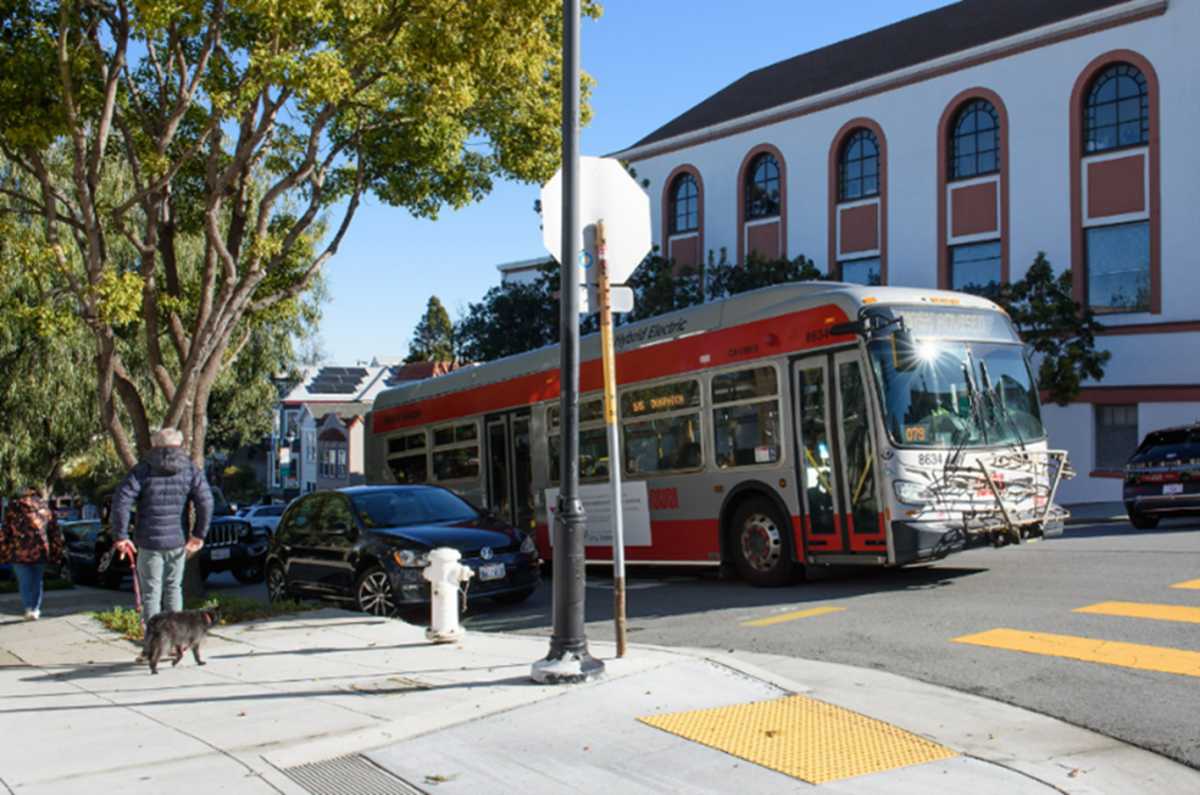Key Takeaway: Flag stops are locations where the bus stops in the travel lane instead of the curb. Without access to the curb, bus operators are not always able to deploy the wheelchair ramp or lower the vehicle for easier boarding. Riders are also at a risk of collision with cars or bicycles in the parking lane. Upgrading these stops will make them safer and more accessible.
About Flag Stops
There are about 3,500 Muni stops in San Francisco. As of 2023, approximately 52% of these stops do not have full bus zones or bus bulbs and there is insufficient space for the bus to pull adjacent to the curb.
These stops, known as flag stops, require Muni buses stop in the travel lane, and riders often must walk or roll in front of parked cars to board at the front door and between parked cars to get on or off the rear doors. Without access to the curb, bus operators are not always able to deploy the wheelchair ramp or lower the vehicle for easier boarding. Current estimates show that there about 1,850 flag stops, including about 1,300 nearside flag stops and 550 farside or mid-block flag stops.
At some flag stops, bus drivers may be able to deploy the wheelchair lift in the street or crosswalk, but often people with mobility difficulties are unable to use that stop altogether. Riders are also at a risk of collision with cars or bicycles in the parking lane. A subset of flag stops are located next to a curb but in active travel lanes — they are not designated bus zones and all other traffic in the travel lane is stopped while bus boarding/alighting takes place. These stops do not present issues for accessibility.
Figure 1. Example of a flag stop, where the bus stops in the travel lane

Flag Stop Upgrades
In 2021, the San Francisco Board of Supervisors unanimously passed a resolution calling for SFMTA to upgrade these stops and “promote unobstructed pedestrian access for boarding public transit by eliminating parking in bus stops.”
In 2023, Muni began an effort to modify all flag stops so that the front door at each bus stop has an adjacent curb that is free from any car or obstruction.
Keeping this area free will allow passengers to have an unobstructed path of travel to and from the front doors of the bus. It also provides a free and clear area at each stop for wheelchair ramp deployment. The project is divided into two phases:
- Phase one will implement 20-foot red curb “clear zones” at all Muni flag stops right before an intersection. These are known as ‘near side” bus stops. There are approximately 900 near side bus stops on our system. SFMTA aims to analyze and modify 50-75 of these stops per a month, beginning with routes identified in the Muni Service Equity Strategy, then move onto stops on our rapid network, and lastly finish by analyzing any remaining near side stops.
- Phase two will paint red curb “clear zones” at the remaining 300 far side or mid-block flag stops. These stops require changes, such as building bus bulbs, converting the stop to a bus zone or transit island, re-locating the stop, or other similar measures, that require more time and outreach to complete than 20-foot clear zones. Stops with existing access complaints will be converted first, followed by stops in commercial areas, and lastly any stops with existing transit shelters.